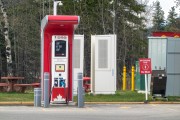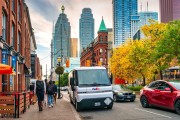It's now officially a smog summer in Toronto. Riding my bike to work this week, I can feel it searing my lungs. But I'm not the only one suffering - behind their rolled-up windows, solitary drivers look frustrated, stalled in construction and bumper-to-bumper congestion.
It's an appropriate time for the Toronto City Summit Alliance to release its brave and ambitious report aimed at reducing traffic congestion and funding transit in the GTA (greater Toronto area).
 Toronto has claimed world-class status with the worst traffic congestion in North America, even worse than highway-bound L.A, yet we are the only major OECD city without road tolls, congestion charges, regional gas taxes or similar road pricing mechanisms to deal with these challenges. The City Summit Alliance report presents a clear case for considering some of these critically necessary solutions, and hopefully policy makers (and mayoral candidates) will muster up the courage to champion them.
Toronto has claimed world-class status with the worst traffic congestion in North America, even worse than highway-bound L.A, yet we are the only major OECD city without road tolls, congestion charges, regional gas taxes or similar road pricing mechanisms to deal with these challenges. The City Summit Alliance report presents a clear case for considering some of these critically necessary solutions, and hopefully policy makers (and mayoral candidates) will muster up the courage to champion them.
The problem is that traffic issues are oddly polarized in Toronto, as commuters and decision-makers seem to interpret measures to reduce the volume of cars on the road and promote cleaner, healthier and safer ways to get to work as attacks against the automobile itself.
True, there is a war in the GTA every day, but it's not on the car - it's a losing, stressful battle against gridlock to get home and spend time with family or walk the dog. Toronto's average daily commute - 80 minutes - is the longest in North America, and considering future population growth and development, it's only set to rise.
Three months ago, Pembina released Driving Down Carbon, a report that examines greenhouse gas emissions from Ontario's vehicles and calculates how improvements to government policies can greatly reduce emissions. Our priority recommendation was to develop a long-term funding strategy to implement Metrolinx's "the Big Move", so we were pleased to see the Alliance report focus on this.
 However, even if Metrolinx were fully funded and implemented, our modeling concludes that every year the volume of traffic will continue to increase. We need a suite of complimentary actions, mainly by the provincial government, to reverse this trend.
However, even if Metrolinx were fully funded and implemented, our modeling concludes that every year the volume of traffic will continue to increase. We need a suite of complimentary actions, mainly by the provincial government, to reverse this trend.
Building transit is essential, but urban planning must locate development within access to this transit and put stronger limits on both sprawl and the construction of highways that service it. Current provincial planning policy allows for 60 per cent of new development to occur in 'greenfield areas' - undeveloped outer regions and farmland, which can only be accessed by car or 30-minute wait times for buses.
We need policies that promote greater intensification, or at least level the playing field by ending subsidies to sprawl that make it more expensive to build and buy a home in desirable urban centres that are walkable and enjoy access to rapid transit.
In addition, "commuter choice" policies can offer mortgage benefits for people to live close to work, and pay as you drive insurance can encourage people to leave the car at home more often. There are tax incentives to take transit and employer benefits such as company carpooling, transit passes and bike facilities.
For those drivers who just can't let go of the steering wheel, the province needs to get moving on electric vehicle infrastructure and provide incentives for drivers to choose more efficient vehicles, including ones powered by plugs.
It's all about choices. If a driver lives within access to rapid transit, a road toll is fair. Parking fees and congestion charges make good economic sense in the urban centres where other options exist. And people may choose to live close to work in a walkable community if there are affordable options to do so.
Lets start there, and with the money raised we can build more transit and smart growth infrastructure. But it's time for politicians to stand up to developers and start rewarding cleaner, healthier options to live and get around.
Then we can all breathe easier.






